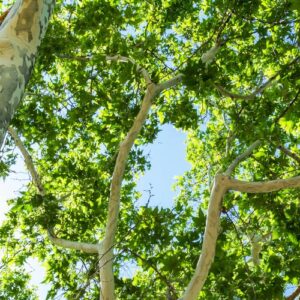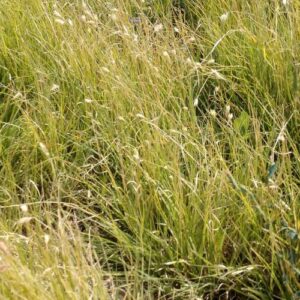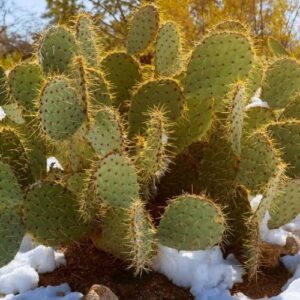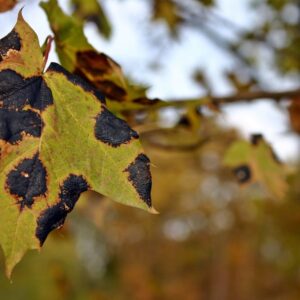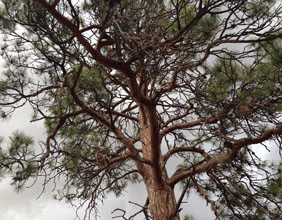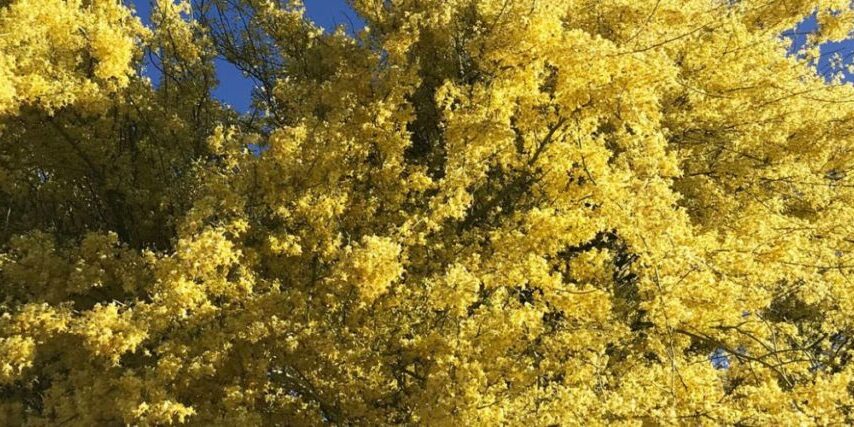
I was sitting outside a coffee shop the other day, watching appreciatively as a palo verde tree’s bloom-laden branches swayed gracefully in the breeze. The contrast of the bright yellow against the shockingly deep blue sky was mesmerizing. As I was admiring the tree, a couple walked out of the coffee shop. Catching sight of the tree, one of them grumbled, "Ugh, pollen!" and walked away from the tree as quickly as possible.
As an allergy sufferer myself, I understood. Allergies are miserable. If I don’t take an antihistamine daily, I can barely suffer through the day. Pollen is the source of most spring allergies, though some mold, dust, and pollutants cause allergies as well.
But the bright, yellow flowers on the spring palo verde tree are not the only thing causing spring allergies here in the Phoenix area – and they are far from the worst culprit.
Pollen and Pollination
When you think of pollen, or when you add it to the top of your acai bowl, you picture a bright yellow, powdery substance. Perhaps the color association is one of the reasons that the yellow flowering palo verde trees shoulder so much of the blame. Not all pollen is yellow, but many flowers produce yellow pollen to attract pollinators such as bees who can’t see red.
There are two ways that pollen is spread. One is through pollinators such as bees, insects, hummingbirds, and butterflies. The other method is by the wind.
You can easily recognize plants and trees that rely on animals and insects to spread pollens, as they are often brightly colored, showy, with large petals and designs to attract the pollinators. The pollen is somewhat sticky so it easily attaches to pollinators and is spread as they move from flower to flower.
Wind-pollinated plants, however, are less likely to be brightly colored. With no need to attract pollinators, they are not showy or ornate. In fact, large blossoms or petals could prevent wind from spreading the pollen. This pollen is not sticky, so that it can travel far distances. According to allergy specialists, it’s wind-borne pollen that causes the majority of spring allergies.
Now, with those two descriptions in mind, which one most resembles the blooms on a palo verde tree?
If you guessed animal/insect-pollinated, you are correct! Palo verde trees are usually pollinated by beetles, flower-loving flies, and bees.
They have the sticky sort of pollen, and as you can see, they have very bright, showy flowers. You can spot a flowering palo verde tree from blocks away.
Then What is Making Me Sneeze?
Arizona used to be the place where doctors would send allergy-sufferers, but, in an ironic twist, the Phoenix and Tucson areas are now some of the worst areas in the country for allergy sufferers. In fact, Phoenix was named as the second-worst big city in the United States for allergies, with only Dallas surpassing us.
While flowers and flowering trees are usually thought to be at fault, it is much more often grasses and non-native trees that cause allergic reactions. Below are the most common culprits.
Bermuda Grass
Transplanted here from other locales and discovered to be a type of grass that works well in our climate, Bermuda grass is found in almost any grassy area in the Phoenix area (think lawns, parks, golf courses). Unfortunately, it is one of the main causes of pollen allergies, and is classified as "extremely allergenic." It flowers at only half an inch tall, and produces a large quantity of pollen.
Pollen from Bermuda grass can travel several miles, so even if you don’t have it on your property, you can still suffer from the extreme allergic reactions it can cause. While most other allergy-causing pollens cease production when temperatures reach over 100 degrees for a few weeks, Bermuda grass can cause year-round allergies. Bermuda grass particles have been found in dust storms, and the pollen from Bermuda grass has been known to trigger asthma attacks.
*Note that the invasive Buffelgrass is similar but not quite as bad as Bermuda grass.
Ragweed
You know how Phoenix was number 2 in the list of worst places for allergies? Well, that same report listed Phoenix as number 1 for ragweed allergies.
Usually a fall allergen in the rest of the country, ragweed allergies are the worst here in spring. Although it is found all over North America and is the cause of what some refer to as “hayfever,” it can reach extremely high levels in the Phoenix area.
Mulberry and Olive Trees
Both olive and mulberry trees were transplanted here because they reminded people of cooler climates, and because they adjusted well to the desert landscape.
Now banned from Tucson (since 1984), Las Vegas (in 1991), and El Paso (in 1992) because of their extremely high pollen production, mulberry trees do well in heat and are very drought resistant. These berry-laden trees, which can also be found in shrub form, produce so much pollen that you can sometimes see the trees releasing it.
Olive trees, likewise, produce a large quantity of pollen that travels through the air on windy days. Some varieties of olive trees are less allergenic, but the European olive tree is one to avoid if you suffer from spring allergies. Like the mulberry tree, it is banned in some areas.
Mesquite Trees
Not all allergy offenders are non-native. Mesquite trees are native deciduous trees, but they do produce a moderate amount of pollen.
Other Allergy-Causing Plants
Other known offenders in our area include:
- Trees/shrubs:
- Juniper
- Ash
- Tamarix (salt cedar)
- Elm
- Cypress
- Pecan
- Privet
- Sycamore
- Black Walnut
- Rabbitbush
- Grasses:
- Kentucky blue
- Annual rye (not perennial or winter rye)
- Fescue
- Salt
- Fountain
- Pampas
What Pollen is Making Me Sneeze Right Now?
Almost all of the plants, trees, and shrubs listed above produce more pollen than palo verde trees, and therefore impact allergies a lot more. While palo verde trees are becoming more abundant and are producing more flowers with the increase of carbon dioxide and milder temperatures, they by no means are the main source of seasonal allergies. Although it should be noted that they do still produce pollen, so if you are allergic to pollen, you are probably allergic to palo verde trees – and a lot of other trees, plants, and grasses. The next time you hear someone say something negative about palo verdes and allergies, stand up for our state tree!
Non-Native Plants Brought to Arizona Increased Pollen Counts
Although Arizona used to be a recommended destination for allergy sufferers, doctors have not purposefully sent their allergy-suffering patients to the desert for a few decades now. As stated in a New York Times article from 1987:
Allergists now strongly discourage patients from moving to the Southwest. "If a doctor sends a person to Arizona, he's exasperated," said Dr. Jacob L. Pinnas, director of allergy and immunology services at the University of Arizona Health Sciences Center. "The patient has either awakened him during the middle of the night - or he's not paying his bill."
If you have lived elsewhere and moved to the southwest, chances are that your allergies have gotten worse since moving here.
The mild winter climate, the addition of non-native plants in large quantities over the years, and the spreading of native plants with high pollen (like ragweed), have all contributed to the increase in allergy symptoms. It’s estimated that 1 out of every 5 people here suffers from allergies.
Allergies Are Getting Worse
Mild and wet winters lead to worse allergies in the spring, as healthy, hydrated plants produce more pollen. Rain in the spring can promote pollen growth, and wind (with or without rain) can move pollen and mold into the air.
In recent years, allergies have begun as early as January, when the brittlebrush and other wildflowers begin blooming. Ash, juniper, and mulberry produce pollen around that time as well.
The climate and sunny days in the Anthem and Phoenix area encourage many kinds of plant growth, and more plants means more pollen.
As temperatures continue to rise, allergies continue to worsen. Studies have shown that longer growing seasons worldwide have led to more and more pollen in the air, making allergy season longer and allergy symptoms worse.
As stated in a Vox article, "It’s not your imagination. Allergy season gets worse every year:"
"More pollen usually means more seeds, which means more ragweed in the next season. And warmer average temperatures mean that spring starts earlier and winter arrives later, giving pollen producers more time to spew their sneeze-inducing particles."
Add to that the dry air and dust in our area, and seasonal allergies can easily become a year-round problem.
What Are Some Trees & Plants That Are Low-Allergenic?
While the miles around your property affect you just as much, if not more, than the plants on your own land, it’s still helpful to ensure that the plants in your yard have low allergenic properties. We picked a few that were also on Anthem’s approved plant list.
- Anachacho Orchid Tree (Bauhinia congesta)
- Bougainvillea
- Cat's Claw (Macfadyena unguis ‐ cati)
- Cactus and succulents
- Arizona Grape Ivy, Desert Grape Ivy, Sorrelvine (Cissus trifoliate)
- Mexican Bird of Paradise (Caesalpinia mexicana)
- Pyracantha, Fire‐thorn (Pyracantha spp.)
- Yucca
- Flowering shrubs
If you have a vegetable garden, don’t fret. Vegetable plants usually do not cause any problems as their pollen is not airborne.
When Do Allergies Subside?
Once we’ve had a few weeks of 100 degree plus temperatures, most allergies will subside. However, some grass pollens continue throughout the hot summer months. While most seasonal allergies are pollen-related, allergies to mold, dust mites, and animals are also common. See your physician to determine the exact cause of your allergies.
See Our Latest Articles
More Articles Like This

Titan Tree Care is a full-service tree care company located in Anthem, AZ and serving all of North Phoenix. We offer a wide range of services to meet your tree care needs, including tree and palm trimming, tree pruning, tree removal, stump grinding, and more. We also offer insect or disease treatments and fertilization services. We are dedicated to providing high-quality, safe, and effective tree care services to our customers and work hard to ensure that your trees are healthy and look their best.




